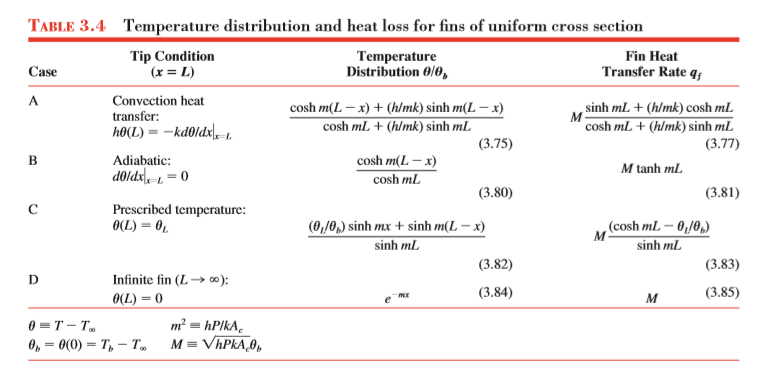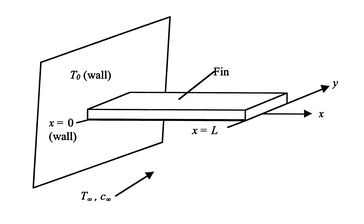Fin Heat Transfer Which Tip Condition Do I Use
Since the surface area of the fin tip is usually very small fraction of the total fin area the tip can be assumed to be insulated. The heat transfer from the base of the fin is due to conduction and from the surface to the atmosphere is due to convection.

Solved The Extent To Which The Tip Condition Affects The Chegg Com
The heat transfer from the fin to the heat transfer occupied by the fin without fin attached.

. Lets say there is a fin that is 1mm thick extends 8mm from the surface and is 10 mm wide. In this case the boundary condition at the tip is 0 dx d. Heat transfer from the tip to be negligible since it is proportional to its surface area.
For the first case the second boundary condition is that there is free convection at the tip. Cosh mL-x cosh mL M tanh. From Fin Tip A practical way of accounting for the heat loss from the fin tip is to replace the fin length L in the relation for the insulated tip case by a corrected length defined as Corrected fin length L c is defined such that heat transfer from a fin of length L c with insulated tip is equal to heat transfer from the actual fin of length L with.
The extent to which the tip condition affects the thermal performance of a fin depends on the fin geometry and thermal conductivity as well as the convection coefficient. The final heat transfer equation is in the form of zeroth order Bessel equation. 1811 This is the solution toEquation 1810 for a fin with noheat transfer at the tip.
The rate of heat transfer is calculated for an adiabatic tip no heat transfer through the tip surface and for a tip that has heat transfer by convection. Fin efficiency is the ratio of heat transfer from the actual fin to the heat transfer of an imaginary fin of the same geometry and same conditions but with an infinite conductivity In other words if the entire fin surface was in a temperature equal to that of the fin base. No-fin heat transfer rate.
TABLE 34 Temperature distribution and heat loss for fins of uniform cross section Tip Condition x L Temperature Distribution θ0b Fin Heat Transfer Rate q Case Convection heat transfer. The equation of the fin is T-T C1 sinh mx C2 cosh mx where C1 and C2 are constants to be found and m2 hP kA where h is the average convective heat transfer P is the perimeter of the fin k is the thermal conductivity of fin A is the cross sectional area of fin. Here heat conducted to the tip of the fin must be equal to the heat convected away from the tip to the ambient ie.
The effectiveness is ε heat transfer wihout fin hea transfer with fin qnf qf 141 23. Cosh mL-x hlmk sinh mL-x cosh mL hlmk sinh mL sinh mL hmk cosh mL cosh mL hlmk sinh mL 377 375 Adiabatic. The maximum reported heat transfer rate through the triangular rooted-finned wall is recommended to utilize the triangular rooted-fin as a heat transfer enhancer for high mechanical strength structures exposed to highly convective fluid streams.
Solving the two equations given by the boundary conditions for and gives an expression for in terms of thehyperbolic cosine or. Boundary and initial conditions are needed to solve the governing equation for a specific physical situation. Bundles of Fins Finned Surfaces Fins are often placed on surfaces in order to.
The boundary condition at is that the temperature gradientis zero or. Note that the heat transfer at base is 9867 W. There are four commonly possible fin tip conditions however.
It also helps in evaluating the percentage error in the assumption of negligible heat transfer at the tip of the fin. Initial conditions are the conditions at time t 0. To download our notes please visit on my website link given below dont forget to subscribe my channel or like it For Engineering Notes- httpengineering.
The fin is exposed to a moving fluid. 31 k A c. One of the following three types of heat transfer boundary conditions typically exists on a surface.
Fin E ciency The n e ciency is de ned for ns with p erfect base con tact and adiabatic tip as. The internal heat generation for both the fin is zero. However since the cross-sectional area of annular disc fins is constant the fin material does not effectively conduct heat near the fin tip.
Fin effectiveness equal to 1 means that there is no enhancement of heat transfer at all by using the fin. 1-D Fin Tip Boundary Condition Corrections. Values of Q fin depend on the conditions at the tip of the fin and may be obtained from Table 6.
DT dx x L. If the fin effectiveness is less than 1 that means that the fin actually reduces the heat transfer by adding additional thermal resistance. Consider an alloyed aluminum k 180 Wm-K rectangular fin of length L 10 mm thickness t 1 mm and width w t.
Can we assume the adiabatic tip. This is sort of the quality assurance QA method for the code and not the analytical methods described in the textbooks on heat transfer. If the percentage error is negligibly small the.
The tip can be exposed to convective heat transfer insulated held at a constant temperature or so far away from the base as to reach the ambient temperature. Extended surfaces fins are used to enhance the heat transfer rate between a solid surface and adjoining fluid. The fin is a good application that involves combined conduction convection and radiation effects.
Fin of finite length losing heat from its end by convection. 8 in their paper studied heat transfer characteristics of natural. Heat loss from the fin is by natural convection to the surrounding air which is at 25 C.
Standard practice to augment the heat transfer from a primary cylindrical surface. This value can be used to calculate temperature profile T x for Heat Flux base - Adiabatic tip boundaries to ensure that the temperature at base is same as in previous case. QnfhAbTsT 140 While the heat transfer from the fin can be evaluated from Table 21 and 22 as.
A Temperature at the surface is specified b Heat flux at the surface is. Q n Q ideal 1 where the ideal n heat transfer rate is de ned as Q ideal Z L 0 hP dx whic h b ecomes Q ideal hP L b when x b whic h corresp onds to ns whose thermal conductivit y approac hes in nitely large v alues. The varying cross-sections are assumed to be triangular and parabolic.
The temperature decreases down the fin due to conduction and to heat being lost by convection. The base temperature of the fin is Th 100DegreeC and the fin is.


No comments for "Fin Heat Transfer Which Tip Condition Do I Use"
Post a Comment